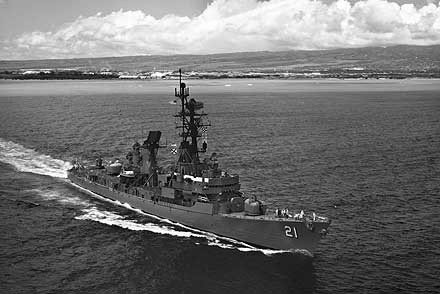 |
||||||||||||
|
January/February 2015
BY JOHN PRADOS One of the most ambitious U.S. Navy operations of the Vietnam War began with an Army general obsessed with rice and a Navy admiral looking for a mission. It was late 1968. Tet dominated the rear-view mirror. Gen. Creighton V. Abrams had succeeded to the top seat at the Military Assistance Command, Vietnam. Abrams wanted and needed a new strategy. His predecessor, Gen.William Westmoreland, had believed in attrition, in striking the enemy down. But all the assessed losses had not prevented the adversary from attacking all across South Vietnam. Indeed, the Tet Offensive took place just when Westmoreland thought he had reached the crossover point where MACV started winning the war. Body count measured attrition, but Abrams believed those figures were too easily manipulated and misinterpreted.
Supply caches were the foundation of the insurgency’s capabilities. Feeding and arming a force—under fire in a land the North Vietnamese and Viet Cong did not control—meant every kind of supply had to be pre-positioned, stocked, and moved under fire. Make war on the supplies, capture the caches, Abrams reasoned, and you had a way to devastate the enemy. At this point—the fall of 1968—the U.S. Navy switched its theater commander. For eighteen months Rear Adm. Kenneth L. Veth had been the Commander of Naval Forces Vietnam (COMNAVFORV). Now the Navy brought in Vice-Adm. Elmo R. Zumwalt to replace him. Zumwalt’s biggest command had been a destroyer. What Adm. Zumwalt had was smarts, conviction, and a knowledge of the arcane new skill called “systems analysis.” He arrived in Vietnam sensing that the Navy lacked an operational focus, and he was determined to find it. Zumwalt visited all the components of COMNAVFORV and spoke to the frontline sailors. One of Zumwalt’s stops was at Dong Tam on the Mekong River, home to the River Assault Flotilla, the naval component of the Mobile Riverine Force. This unit combined naval vessels with Army troops for a real amphibious force, providing a major strike capability in the Mekong Delta and the southernmost portion of South Vietnam. Capt. Robert S. Salzer led the assault flotilla, also known as Task Force 117.
The month that Zumwalt arrived, Game Warden had searched some 11,000 vessels. But the enemy dominated the play, determining by its choice of river and canal routes and the timing of shipments which vulnerabilities he accepted. In the month before the Tet Offensive the Game Warden force had seized only twenty-two weapons and six-and-a-half tons of rice. Salzer argued that if Task Force 116 worked actively to close off selected waterways, interdiction would force the Viet Cong into desperate attempts to move supplies, which could then be stopped. Tracking VC supply movements and plotting networks also would permit the capture of caches, disrupting the enemy’s higher-level operations. The scheme received enthusiastic support from Capt. Earl F. “Rex” Rectanus, COMNAVFORV’S intelligence chief, whom the admiral credited with the idea. Others on Zumwalt’s staff say the initiative was Salzer’s.
Gen. Abrams was anxious for Adm. Zumwalt to present his general concept. One of Zumwalt’s staff noticed that when Veth took the incoming admiral in to see the Top Boss, Abrams did not even acknowledge Veth’s presence, focusing entirely on his successor. Before heading to Vietnam, Veth had been the Navy’s chief lobbyist in Congress. In Saigon he seemed out of place, doing the political stuff more than focusing on command. There was no particular reason to suppose Zumwalt would be any better. That was before the admiral’s Friday briefing. The MACV commander asked for something on paper. By Monday Zumwalt had a detailed prospectus. Abrams promptly accepted and asked what he could do to get the Navy what it needed. This was the genesis of the Navy’s first strategic interdiction operation in Vietnam, SEALORDS—Southeast Asia Lake Ocean River Delta Strategy. Zumwalt’s staff records the origins of that name: Zumwalt intended to make Bob Salzer the fighting admiral of this endeavor. In the British navy, control of the fleet went to top officers called “sealords,” with the First Sealord in charge. Zumwalt was pleased to make Salzer a sealord and named the operation accordingly.
The PBRs worked from mother ships, getting accommodation aboard converted LSTs (Landing Ship Tanks, amphibious craft with several thousand tons displacement). At important locations where SEALORDS needed a more permanent presence, the LSTs became the basis of shore facilities (Advanced Tactical Support Bases), such as Dong Tam. Behind the patrol boats loomed the River Assault Flotillas of the Mobile Riverine Force, Salzer’s command. For strikes against small VC units or on supply caches, there were the combat swimmers of SEAL Teams One and Two. The coastal patrol vessels of Task Force 115 were pulled in to monitor the Mekong and Bassac Rivers. That afforded SEALORDS access to bigger Swift boats (PCFs), Coast Guard cutters, and motorized sampans. The South Vietnamese Navy contributed its own river assault groups. SEALORDS also had its private air arm in the form of Helicopter Attack Squadron UH-1L attack copters, known as the “Seawolves,” and Light Attack Squadron GV-10 Broncos, the “Black Ponies.” The whole force was designated Task Force 194 with Capt. Salzer at its helm.
Operating out of An Thoi, there were incidents in February and March 1969 (in the latter, Kerry received the Silver Star) that became controversial when Kerry ran for president. A group of Vietnam veterans, including Rex Rectanus, denied details of the actions. The other controversy concerned Joseph Robert (“Bob”) Kerrey, a lieutenant and platoon leader in SEAL Team Two. Kerrey, who ran for president in the 1992 Democratic primary, received the Medal of Honor for a mission near Nha Trang in March 1969. But a month earlier he led his team on a snatch operation at a hamlet called Thanh Phong in the Mekong Delta. Mike Demske was a sailor with Coastal Division 11. He crewed on PCF-94, in the same unit as John Kerry’s Swift boat. He doubted the Vietnamese allies. In one firefight the Americans called in supporting South Vietnamese boats to replenish their mortar ammo. When the Swifts arrived and U.S. sailors jumped aboard to open the ammunition lockers, they found that their allies had dumped their mortar shells and filled the lockers with fishing nets.
The jungle went right up to the river banks, until Adm. Zumwalt ordered the spraying of Agent Orange along the waterways. The Swifts would go in at night, creep up to the riverbanks, and watch. In some canals or streams, when the boats could not turn around, they would have to back out. Demske believes that three-quarters of the sailors on the Swifts became casualties. His boat was shelled by North Vietnamese regulars one day in May 1969, and they sat for twelve hours before anyone arrived to tow them out. Elmo R. Zumwalt III—the admiral’s son—was a Navy lieutenant. He skippered PCF-35 based at Ha Tien on the South Vietnam-Cambodia border. Young Zumwalt’s Swift patrolled in the Gulf of Siam and on canals that led into neutral Cambodia, and was involved in firefights across the border. On one occasion a Swift in company with PCF-35 was mined. His father worried that Lt. Zumwalt took extra—and unnecessary—risks. The admiral’s decision to employ Agent Orange to force the VC back from the waterline had personal consequences: Young Zumwalt died from cancer at age 42. Adm. Zumwalt remained convinced to the end of his days that his son had died from exposure to Agent Orange. The VA now holds service aboard any Swift boat, PBR, LST, accommodation ship, or landing craft as a reason to award disability benefits based on exposure to Agent Orange.
Kelly’s detachment spent a week at Ha Tien before going on to the next operating base, eventually to return to home base at Binh Thuy, near Can Tho. Capt. Arthur H. Munson led the Seawolves. He put Detachment 5 at Dong Tam permanently. They had three weeks to relocate from the Army to the Navy side of the airstrip, but had no bunker material, lumber, cement, sandbags or pierced steel plating. For a bottle of rum and three cases of beer, the sailors liberated several trucks of lumber and a forklift from the Army. More beer opened the cement plant. Those were not the kinds of items that made it into The Jackstaff News, NAVFORV’s newspaper. Meanwhile, it was in the summer of 1968, shortly before Zumwalt’s arrival in country, that sailors of Task Force 116 learned they would not be getting additional helicopters but rather the fixed-wing aircraft of the Black Ponies. Cmdr. Gilbert L. Winans would be the first CO of Light Attack Squadron 4 at Binh Thuy. SEALORDS interdiction curtains went up quickly. They were nearly complete by the spring of 1969. Phase II began that April and focused more on the far south. Progress was judged sufficient that the Riverine Assault Force (Task Force 117) was de-activated in August 1969, the first major U.S. Navy element to head home.
The enemy was concerned enough that, on October 20, 1970, they mounted a full-scale raid on Sea Float, destroying the pontoon part of the base. In its first year the SEALORDS were credited with destroying or capturing more than five hundred tons of enemy supplies, killing three thousand NVA and VC, and capturing an additional three hundred. Allied losses amounted to 186 killed and 1,451 wounded. The remainder of the PBRs and Swifts and the U.S. apparatus of SEALORDS were transferred to the South Vietnamese on an accelerated basis by the end of 1970. In 1972 the South Vietnamese felt comfortable enough about the security situation in the far south that Saigon pulled a full infantry division out of IV Corps to fight in the battles near the Cambodian border. In a war where so many things went wrong, SEALORDS was one thing that went right.
|
||||||||||||
|
|
||||||||||||
|
|
||||||||||||
8719 Colesville Road, Suite 100, Silver Spring. MD 20910 | www.vva.org | contact us |
||||||||||||










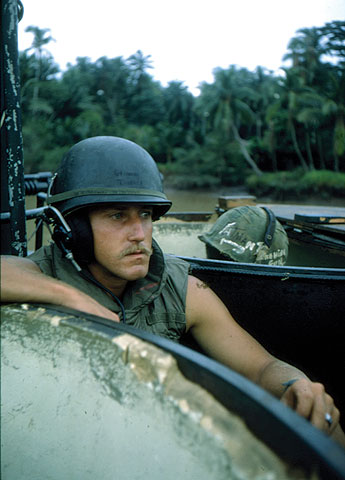 He wanted something that measured capabilities more directly. Over the summer of 1968, in breaking up the second and third waves of the NVA and Viet Cong’s Tet effort, several large supply caches were captured. Suddenly Gen. Abrams found his solution: rice.
He wanted something that measured capabilities more directly. Over the summer of 1968, in breaking up the second and third waves of the NVA and Viet Cong’s Tet effort, several large supply caches were captured. Suddenly Gen. Abrams found his solution: rice. 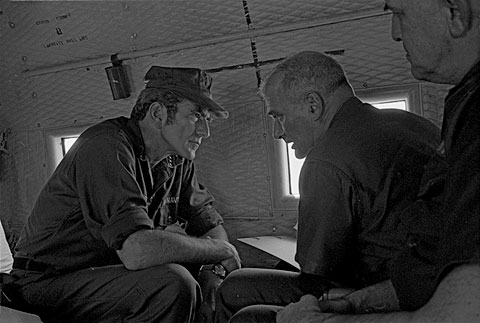 Salzer bent Zumwalt’s ear, trying to convince him that U.S. delta strategy needed to be more aggressive. Naval forces primarily had interdiction and support roles, but those functions were passive. Operation Market Time, carried out off the coast by Task Force 115, checked seagoing traffic for smuggled supplies. Operation Game Warden—Task Force 116’s effort on the rivers, principally in the Mekong Delta—did the same for the small dugouts and sampans that crowded the inland waterways. Salzer’s assault flotilla furnished the heavy backup.
Salzer bent Zumwalt’s ear, trying to convince him that U.S. delta strategy needed to be more aggressive. Naval forces primarily had interdiction and support roles, but those functions were passive. Operation Market Time, carried out off the coast by Task Force 115, checked seagoing traffic for smuggled supplies. Operation Game Warden—Task Force 116’s effort on the rivers, principally in the Mekong Delta—did the same for the small dugouts and sampans that crowded the inland waterways. Salzer’s assault flotilla furnished the heavy backup. 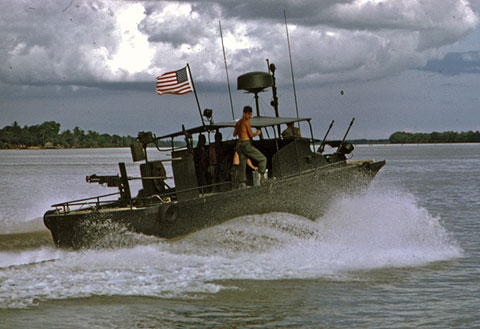
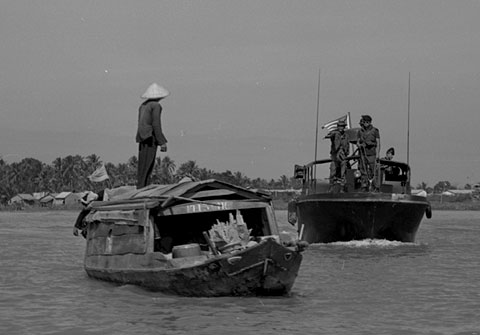 SEALORDS became the generic label for an offensive operation that drew on almost all of the Navy’s 38,000 sailors in Vietnam. Capt. Robert Powers furnished the scout and patrol elements with his Task Force 116. It fielded light but heavily armed boats (PBRs for Patrol Boat, River), which deployed forward on the rivers and canals. Crews joked they were the “Pabst Blue Ribbon” navy. The PBRs were grouped in river sections, divisions, and squadrons. One river division modified the beer’s logo for its unit patch.
SEALORDS became the generic label for an offensive operation that drew on almost all of the Navy’s 38,000 sailors in Vietnam. Capt. Robert Powers furnished the scout and patrol elements with his Task Force 116. It fielded light but heavily armed boats (PBRs for Patrol Boat, River), which deployed forward on the rivers and canals. Crews joked they were the “Pabst Blue Ribbon” navy. The PBRs were grouped in river sections, divisions, and squadrons. One river division modified the beer’s logo for its unit patch. 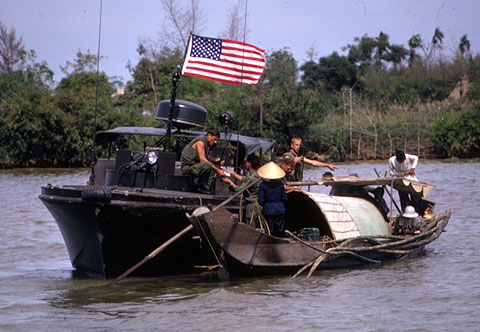 The two most famous episodes of SEALORDS took place in early 1969. Both involved men with similar names who would one day be candidates for president of the United States. One, Navy Lt. John Kerry, currently secretary of state, was the Democratic Party candidate for president in 2004. He skippered Swift Boat PCF-94 of Coastal Division 11 (Task Force 115) in early 1969.
The two most famous episodes of SEALORDS took place in early 1969. Both involved men with similar names who would one day be candidates for president of the United States. One, Navy Lt. John Kerry, currently secretary of state, was the Democratic Party candidate for president in 2004. He skippered Swift Boat PCF-94 of Coastal Division 11 (Task Force 115) in early 1969. 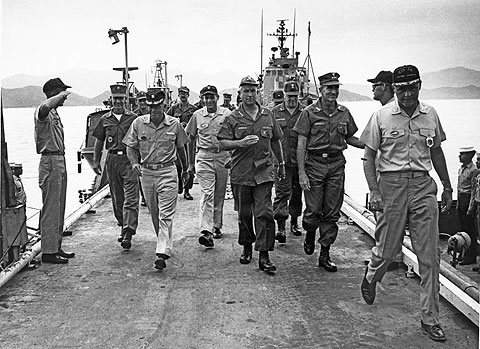
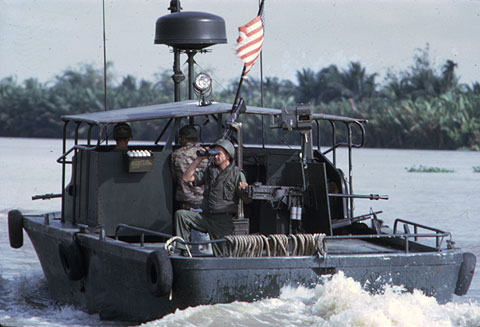 Another who passed through Ha Tien before young Zumwalt was Dan Kelly, a door gunner with HAL-3, the Seawolves. One Navy specialized helicopter squadron for all the Mekong and the Ca Mau Peninsula was obviously not much. The choppers were in huge demand. As a result, the Seawolves rarely operated as a squadron, almost always as flights or detachments parceled out to fields all over the region.
Another who passed through Ha Tien before young Zumwalt was Dan Kelly, a door gunner with HAL-3, the Seawolves. One Navy specialized helicopter squadron for all the Mekong and the Ca Mau Peninsula was obviously not much. The choppers were in huge demand. As a result, the Seawolves rarely operated as a squadron, almost always as flights or detachments parceled out to fields all over the region. 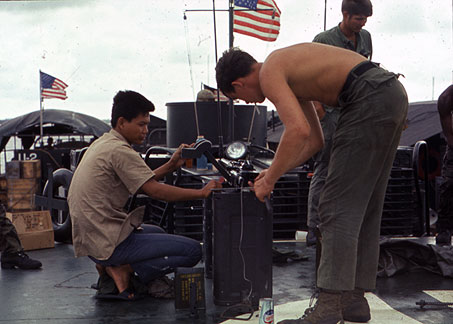 Code names were a mix—“Barrier Reef,” “Giant Slingshot,” “Tran Hung Dao,” “Search Turn,” “Sea Tiger”—but their success led to the even more ambitious “Breezy Cove,” at Song Ong Doc in the Ca Mau, in which SEALs plus SEALORDS forces and South Vietnamese troops created the “Sea Float” riverine base on pontoons. They eventually added a shore facility as well, all deep inside what had been a VC preserve.
Code names were a mix—“Barrier Reef,” “Giant Slingshot,” “Tran Hung Dao,” “Search Turn,” “Sea Tiger”—but their success led to the even more ambitious “Breezy Cove,” at Song Ong Doc in the Ca Mau, in which SEALs plus SEALORDS forces and South Vietnamese troops created the “Sea Float” riverine base on pontoons. They eventually added a shore facility as well, all deep inside what had been a VC preserve. 